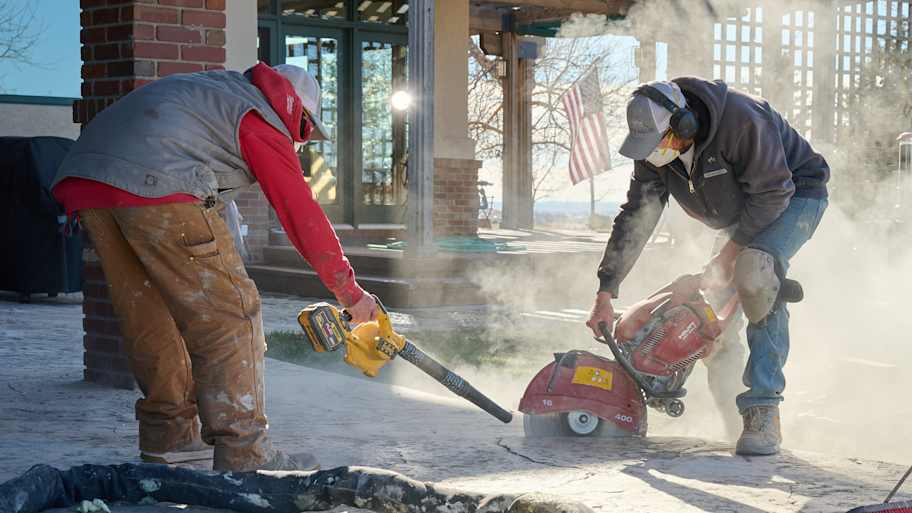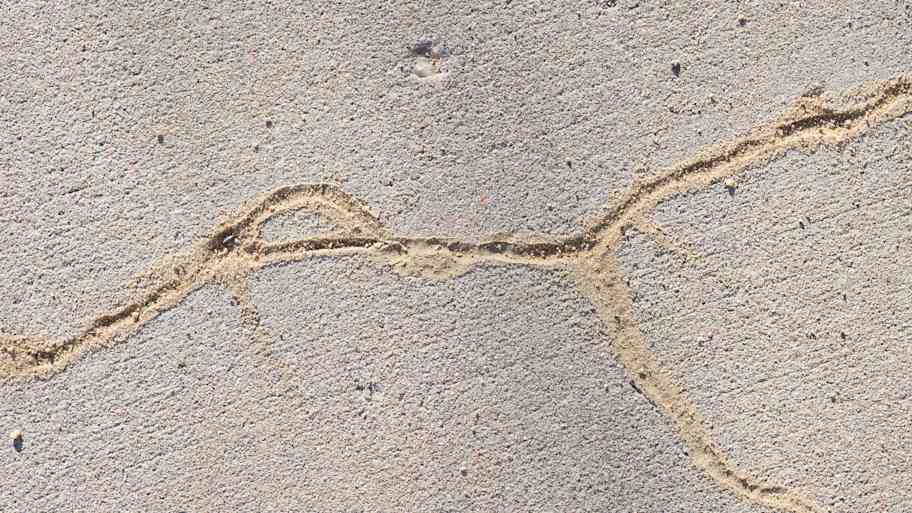Why Is My New Concrete Cracking, and How Do I Prevent It?
Let’s crack the surface on this question


Some concrete cracking is normal and often occurs during the curing process.
Concrete cracks that are less than 0.3 mm wide won’t impact the structure and strength.
Proper installation by a professional contractor reduces cracking.
There’s nothing like the smooth, flawless look of freshly poured concrete. So, of course, it’s frustrating to spot new concrete cracking, especially if you just paid for a new driveway, concrete slab, walkway, or garage floor. But you typically don't need to worry if you see fine lines, spiderweb lines, or shattered glass lines on your concrete surface. Here’s why you have cracks in your new concrete and what you can do about it.
Reasons Why New Concrete Cracks
It’s common for concrete to crack due to the shrinkage that occurs when the concrete dries and hardens. As concrete dries, water evaporates from the mixture, and the size of the concrete slab shrinks. The loss of material creates stress on the concrete. When the stress exceeds the strength of the concrete, cracks form.
While some cracking is inevitable, there are a few things that could cause more cracks to occur.
1. “Plastic Shrinkage” From Water Loss
Before the concrete dries, it’s referred to as “plastic,” a particularly temperamental stage. Hairline cracks in new concrete are completely normal because of rapid moisture loss, also known as “plastic shrinkage,” before it dries.
This shrinkage can’t be avoided, but you can reduce the risk of cracking by curing the concrete with moisture after it’s poured.
2. Too Much Water Added to the Mix
Excess water in the concrete mix can be a significant factor that contributes to more shrinkage. Adding more water can help make the concrete easier to work with, but once that water dries, it can lead to cracking.
3. Concrete Dried Too Quickly
Keep an eye on your concrete slab as it cures. Rapid drying can often cause these cracks, so taking precautions can help prevent them. We’ll talk more about this in the next point.
4. Temperature, Humidity, and Wind
Make sure you’re working during ideal weather conditions and taking proper precautions, like spraying your concrete with water in hot and dry weather and covering it in cool weather and high wind. A reputable concrete driveway pro will know how to keep a concrete slab in good condition for optimal curing.
5. Environmental/Landscaping Factors
In older driveways, soil pressure is a big cause of cracks in concrete foundation blocks. Some other causes of long-term driveway cracks include everything from nearby trees to heavy vehicles. If your concrete is a bit older, a concrete repair pro may be able to help you implement a fix for cracks.
Most Common Types of Cracks
Identifying the types of cracks in your concrete can help you nail down the cause and take steps to prevent further cracking. Since identifying cracks is tough for a layperson, you should also have a pro check them out. However, this guide can help you understand what types of cracks you may be seeing.
| Crack Type | Appearance | Cause |
|---|---|---|
| Hairline cracks | Very small, usually less than 0.3 millimeters wide | Normal shrinkage |
| Plastic shrinkage cracks | Small, thin, and randomly spread out | Quick moisture loss during installation |
| Settlement cracks | Wider at the top and narrower at the bottom | Issues with the ground below the slab, such as soil pressure |
| Overloading cracks | Wide and deep, in a linear or jagged pattern | Too much pressure on concrete, or soil shifting after a rainstorm |
| Structural cracks | Horizontal and wide | Excessive stress or pressure—call a pro ASAP if you suspect these cracks |
Will Cracks in Fresh Pavement Go Away?
Yes, hairline cracks should subside in about a month. While shrinkage cracks can show up on the surface within hours of pouring concrete, it takes an entire month for new concrete to fully settle.
Don't be surprised if cracks that seemed visible at first are nearly impossible to see after a month of settling. You should be able to decide if you can live with the cracks by then. Any crack that's one-eighth of an inch or smaller is considered standard.
When Do Cracks in Concrete Need Repair?
If you notice uneven cracks larger than 1/4 inch, it's often a sign of a bigger problem requiring you to invest in the cost to repair a sidewalk or driveway—or even replace it. A good test is if you can fit a quarter in the crack. Any crack that is 1/8 inch or smaller is typically considered a harmless hairline crack. Tell your contractor if you think something went wrong during pouring.
It’s important that the cracks don’t get wide enough for water to seep into the concrete slab. If this happens, the water can rust the rebar, weaken the foundation, and expand the cracks further. Call in a local concrete repair pro to make sure your concrete is sealed from water damage.
Some Concrete Cracks Are Planned

When cracks can’t be prevented, concrete contractors often use control joints to control where the cracks will end up. Think of cracks in the sidewalk.
Here's how it works:
The contractor spaces the control joints in the concrete.
The joints relieve the pressure.
Cracks form in the right spots.
The cracking is undetectable.
“One of the most common causes of cracking in concrete is due to a lack of control joints and improperly placed control joints,” says Matt DiBara, Expert Review Board member and owner of DiBara Masonry. “In many states, there are codes that regulate how much concrete can be installed prior to installing control joints. If you notice cracking, consult a local contractor about the control joint codes and best practices to see if this common step was overlooked.”
Tips to Prevent and Repair Cracks in Concrete
You can prevent new concrete from cracking by following a careful installation and curing process. Here are a few tips to ensure your concrete doesn’t crack and what to do if it does:
Ask your contractor about their curing process, as properly cured concrete is less likely to crack.
Follow your contractor's instructions about the curing process, such as spraying your concrete up to 10 times per day during the first week.
Ensure your contractor seals the concrete to prevent concrete cracks.
Repair concrete cracks as soon as you notice them to prevent them from getting larger.
Choose a licensed and insured local concrete contractor with favorable reviews.
Frequently Asked Questions
The most common cause of concrete cracks is shrinkage when the concrete hardens and cures. The stress from the shrinkage exceeds the concrete’s strength. Concrete cracking can also occur when it experiences extremely cold or hot temperatures, such as a particularly harsh winter or a firepit built into a concrete patio.
New concrete can crack within 12 hours of finishing, as it can be a common occurrence as the concrete dries and cures. Certain weather conditions and temperatures can slow or speed up the cracking. A concrete contractor plans for cracking during the drying process and keeps some of it at bay by installing control joints.
No, hairline cracks in concrete are generally not a problem as they do not impact the strength and longevity of the concrete. Generally, cracks less than 0.3 millimeter wide don’t impact the structure. Hairline cracks can grow over time and weaken the structure, such as in a home foundation. Some hairline cracks can also cause leaks in a foundation. It’s important to watch the cracks to see if they grow. Contact a concrete contractor if you notice cracks exceeding 0.3 millimeter wide.





- How to Fix Cracks in Concrete
- 7 Tips to Prevent Concrete From Cracking
- What Are Concrete Shrinkage Cracks?
- 6 Concrete Maintenance Tips to Extend Its Longevity
- Can You Pour New Concrete Over Existing Concrete?
- 9 Tips and Tricks for Beginners Working With Concrete
- 9 Common Concrete Problems and How to Fix Them
- How to Dispose of Concrete 5 Ways
- Who Do I Call to Repair Concrete?
- Is a Concrete Pool Right for My Home? Here’s What You Need to Know











